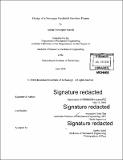Design of a prototype handheld nanoliter pipette
Author(s)
Samsel, Adrian Christopher
DownloadFull printable version (5.877Mb)
Other Contributors
Massachusetts Institute of Technology. Department of Mechanical Engineering.
Advisor
Anastasios John Hart.
Terms of use
Metadata
Show full item recordAbstract
Handheld pipettes are invaluable to scientists in labs across the globe. Due to high inaccuracies at volumes of less than 1 [mu]L, a nanoliter pipette could truly change the way people research. This experimental nanoliter pipette uses a regulating CAM mechanism and a diaphragm to displace small amounts of fluid. The CAM mechanism has the ability to be adjusted to different steps, each of which controls the amount of working fluid to be displaced in a sealed chamber. In response to this, the diaphragm displaces a smaller volumetric amount of fluid outside the chamber. A deamplification ratio is defined by the ratio of the volume displaced by the diaphragm to the volume displaced by the CAM mechanism. The deamplification ratio is adjustable by changing the setting of the variable CAM mechanism or exchanging different tip assemblies which hold different sized diaphragms. In all, this nanoliter pipette enables measuring and dispensing of very small volumes of liquid, ranging from I nL to 1[mu] L, and can expand the tools of every lab researcher internationally.
Description
Thesis: S.B., Massachusetts Institute of Technology, Department of Mechanical Engineering, 2016. Cataloged from PDF version of thesis. Includes bibliographical references (page 26).
Date issued
2016Department
Massachusetts Institute of Technology. Department of Mechanical EngineeringPublisher
Massachusetts Institute of Technology
Keywords
Mechanical Engineering.